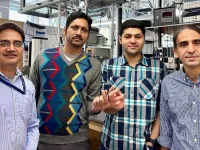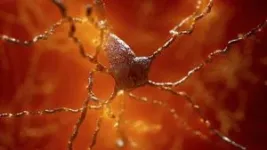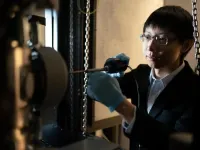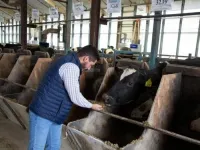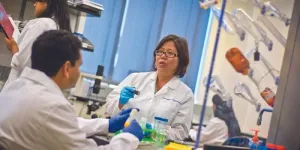(Press-News.org) UNIVERSITY PARK, Pa. — Implantable biomedical devices — like pacemakers, insulin pumps and neurostimulators — are becoming smaller and utilizing wireless technology, but hurdles remain for powering the next-generation implants. A new wireless charging device developed by Penn State scientists could dramatically improve powering capability for implants while still being safe for our bodies, the researchers said.
The new device can harvest energy from magnetic field and ultrasound sources simultaneously, converting this energy to electricity to power implants, the scientists reported in the journal Energy & Environmental Science. It is the first device to harvest these dual-energy sources simultaneously with high efficiency and operate within the safety limits for human tissue, the team said.
“Our device may unlock next-generation biomedical applications because it can generate 300% higher power than the current state-of-the-art devices,” said Bed Poudel, research professor in the Department of Materials Science and Engineering at Penn State and co-author of the study. “By combining two energy sources in a single generator, power generated from a given volume of the device can be significantly improved which can unlock many applications that were not possible before.”
Using this technology, battery-free bioelectronic devices could be miniaturized to millimeter-sized dimensions, making them easily implantable and allowing distributed networks of sensors and actuators to measure and manipulate physiological activity throughout the body. This would enable precise and adaptive bioelectronic therapies with minimal risks or interference with daily activities, according to the scientists.
More traditional implants like pacemakers are typically powered by batteries and charged using cables. But the lifespan of batteries is limited and surgery may be necessary to replace them, posing a risk of infection or other medical complications.
Charging or directly powering implants wirelessly could extend their lifespan, the scientists said. But conventional wireless charging technology used for cell phones and electric vehicles may not be ideal as implants continue to shrink.
“The problem is that as you make these implants less invasive by making them smaller and smaller, the efficiency of wireless charging becomes much lower,” said Mehdi Kiani, associate professor of electrical engineering at Penn State and co-author of the study. “To address this, you need to increase the power. But the problem is that high frequency electromagnetic waves could be harmful to the body.”
Magnetic field and ultrasound energy operating at lower frequencies are attractive options for wirelessly powering or charging implants, according to the researchers. Previous work by other scientists has focused on creating devices that can harvest one of these sources of energy, but not at the same time, the scientists said. However, this single source approach may not provide enough power to charge smaller future medical implants.
“Now we can combine two modalities in a single receiver,” said Sumanta Kumar Karan, a postdoctoral scholar in the Department of Materials Science and Engineering at Penn State and the lead author of the paper. “This can exceed any of the individual modalities because we now have two sources of energy. We can increase the power by a factor of four, which is really significant.”
The devices use a two-step process for converting magnetic field energy to electricity. One layer is magnetostrictive, which converts a magnetic field into stress, and the other is piezoelectric, which converts stress, or vibrations, into an electric field. The combination allows the device to turn a magnetic field into an electric current.
And the piezoelectric layer also can simultaneously convert ultrasound energy into an electric current, the researchers said.
“We have combined these sources of energy in the same footprint, and we can generate sufficient power that can be used to do the things that next generation implants will be asked to do,” Poudel said. “And we can do this without damaging tissue.”
Technology also has implications for powering things like wireless sensor networks in smart buildings. These networks do things like monitor energy and operational patterns and use that information for remotely adjusting control systems, the scientists said.
Other Penn State researchers contributing were Andrew Patterson, professor in the Department of Veterinary and Biomedical Sciences; Anitha Vijay, research technologist; and Sujay Hosur, doctoral candidate. Kai Wang and Rammohan Sriramdas, former assistant research professors at Penn State and Shashank Priya, vice president for research at the University of Minnesota and former professor at Penn State also contributed.
The National Science Foundation supported this work. Some of the researchers on this study received support from the DARPA MATRIX program and the Army RIF program.
END
Dual-energy harvesting device could power future wireless medical implants
2024-02-23
ELSE PRESS RELEASES FROM THIS DATE:
Study: ‘Hexaplex’ vaccine aims to boost flu protection
2024-02-23
BUFFALO, N.Y. – Recombinant protein vaccines, like the Novavax vaccine used to fight COVID-19, offer several advantages over conventional vaccines.
They’re easy to precisely produce. They’re safe, and potentially more effective. And they could require smaller doses.
Because of these traits, there is much interest in developing recombinant influenza vaccines. To date, however, the Food and Drug Administration has approved only one such vaccine.
A University at Bufalo-led research team hopes to add to that number. It is developing a new recombinant flu vaccine – described ...
New structural insights could lead to mechanical enhancement in alloys
2024-02-23
UNIVERSITY PARK, Pa. — A new class of metallic materials with potential applications in airplane turbines, nuclear reactors and equipment for space exploration can withstand extreme temperatures and resist fractures, but scientists haven’t understood why until now. According to a new study co-led by Penn State researchers, the answer could relate to the material’s short-range order, or the local arrangement of atoms within a material. This knowledge could lead to further improvement in the mechanical performance and damage tolerance of these materials, the researchers said, leading in turn to advancements in the safety and reliability of next-generation ...
New research challenges conventional picture of Parkinson's disease
2024-02-23
Parkinson's disease, the second most common type of progressive dementia after Alzheimer's disease, affects nearly 1 million people in the U.S. and an estimated 10 million individuals worldwide. Each year, close to 90,000 new cases of Parkinson’s disease are diagnosed in the U.S.
In a new study, Jeffrey Kordower, director of the ASU-Banner Neurodegenerative Disease Research Center, and his colleagues unveil pivotal insights into the progression of Parkinson's disease, presenting new hope for patients battling the severely debilitating disorder.
The research highlights the role of a critical protein called tau in the early stages of the ...
Dairy cows fed botanicals-supplemented diets use energy more efficiently
2024-02-23
UNIVERSITY PARK, Pa. — Supplementing the feed of high-producing dairy cows with the botanical extract capsicum oleoresin, obtained from chili peppers, or a combination of that extract and clove oil resulted in the animals using feed energy more efficiently and emitting less methane from their largest stomach, according to a new study conducted by Penn State researchers.
Adding those substances, sometimes referred to as essential oils, to the cattle’s rations resulted in improved efficiency of energy utilization in peak-lactation dairy cows. According to Alex Hristov, distinguished professor of dairy nutrition, ...
Aston University receives nearly half a million pounds to create safer and greener batteries
2024-02-23
• Researchers to explore the use of gel electrolyte materials to improve lithium-ion batteries
• The batteries are the most commonly used in electric vehicles and electronics
• Will use non-harmful, non-flammable and renewably sourced materials for next generation battery technologies.
Aston University researchers are to explore the use of gel electrolyte materials to make lithium-ion batteries - the most commonly used for electric vehicles and electronics - safer and less environmentally damaging.
The University has received a grant of £443,058 from the Engineering and Physical Sciences Research ...
New study shows glycan sugar coating of IgG immunoglobulin can predict cardiovascular health
2024-02-23
When people hear about predicting heart disease, most will think of cholesterol levels. While cholesterol is a major contributor to heart disease, a recent study from Brigham and Women's Hospital, a founding member of Mass General Brigham, found that a glycan biomarker of IgG is also an important predictor for cardiovascular diseases (CVD). The researchers studied the sugar coatings on an antibody known as immunoglobulin G (IgG), which is implicated in the immune responses associated with chronic inflammation among participants in two case-control studies. The results of this investigation provide another biomarker for identifying risk of CVD, which could lead to earlier diagnosis ...
Sir Peter Rigby appointed as honorary chair of Aston University’s new Digital Futures Institute
2024-02-23
Sir Peter was knighted for his contribution to IT and businesses in the Midlands in 2002
He will provide guidance, support, advocacy and strong links to industry in his role
The Institute will drive digital innovation and ensure digital inclusion.
Aston University is delighted to announce that it has appointed one of the UK’s most respected and successful business leaders, Sir Peter Rigby, as honorary chair of its new Digital Futures Institute.
The announcement of Sir Peter’s appointment was made in front of guests at the inaugural lecture given by Professor Abdul Sadka, director of the Digital ...
Yale School of Medicine receives a $575,000 grant from PolyBio Research Foundation to fund long COVID research
2024-02-23
Yale School of Medicine and its Center for Infection & Immunity (CII) are receiving a $575,000 grant from PolyBio Research Foundation to fund Long COVID research. The grant—issued via PolyBio’s LongCovid Research Consortium (LCRC)— will support a collaboration to define mechanisms by which the SARS-CoV-2 virus can persist for long periods of time in tissue and blood.
There is growing evidence that SARS-CoV-2 may not fully clear from Long COVID patients after initial infection. Instead, reservoirs of the virus can persist in patient tissue for months or even years, with recent research finding the SARS-CoV-2 ...
Common plant could help reduce food insecurity, researchers find
2024-02-23
UNIVERSITY PARK, Pa. — An often-overlooked water plant that can double its biomass in two days, capture nitrogen from the air — making it a valuable green fertilizer — and be fed to poultry and livestock could serve as life-saving food for humans in the event of a catastrophe or disaster, a new study led by Penn State researchers suggests.
Native to the eastern U.S., the plant, azolla caroliniana Willd — commonly known as Carolina azolla — also could ease food insecurity in the near future, according to findings ...
Innovative chemotherapy approach shows promise against lung cancer
2024-02-23
Lung cancer is not the most common form of cancer, but it is by far the deadliest.
Despite treatments such as surgery, radiation therapy and chemotherapy, only about a quarter of all people with the disease will live more than five years after diagnosis, and lung cancer kills more than 1.8 million people worldwide each year, according to the World Health Organization.
To improve the odds for patients with lung cancer, researchers from The University of Texas at Arlington and UT Southwestern Medical Center have pioneered a novel approach to deliver cancer-killing drugs directly into cancer cells.
“Our method ...
